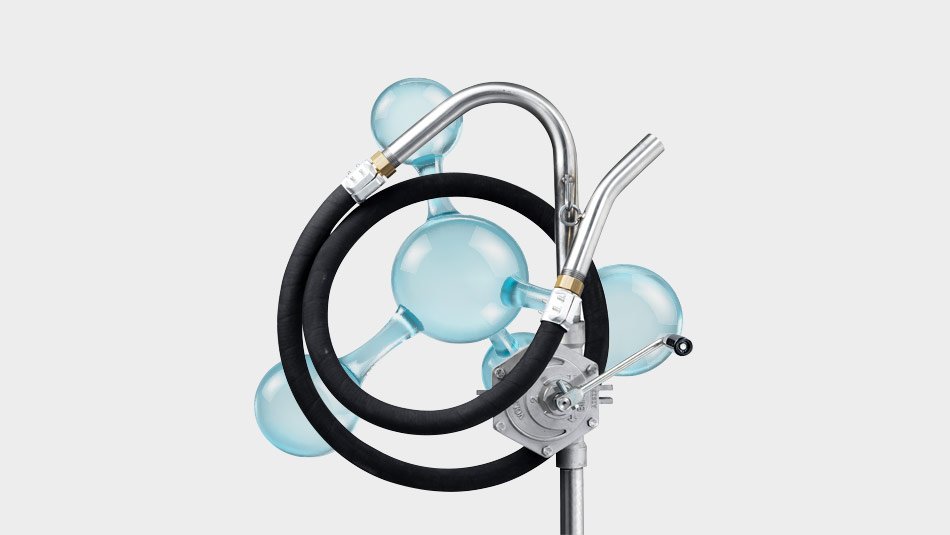What are the advantages of barrel pumps in the chemical sector?

Everything you need to know about the advantages of barrel pumps in the chemical industry.
For security reasons, the transfer of acids, solvents and chemical products is performed with a special pump: the barrel pump.
They enable aggressive, flammable and corrosive fluids to be pumped from one container to another. How do these hydraulic pumps work? What are their particularities? And why are they chosen for the chemical industry? Presentation of a transfer pump adapted to many industrial draining applications.
Need advice?
Our team of experts is here to help you.
You can contact us via a simple click:
What is a barrel pump?
The operating principle of barrel pumps
These are centrifugal or displacement pumps with axial control.
They consist of a drive shaft, and a helical rotor or worm screw that is placed at the extremity of the tube, with the motor at the opposite end. When the later is started, the pump body begins to move, as does the rotor of the screw pump. The rotation of this impeller enables the fluid to move along an axis that is parallel to the drive shaft to lead it to the discharge hose and enable its evacuation.
Thus, barrel pumps are designed with a tube whose length depends on the size of the container to be pumped. It must always remain totally immersed in the liquid to facilitate priming and to operate correctly. Axial pumps operate without fluctuations.
The particularities of these pumps
This type of pump offers a wide range of flow rates and pressure, expressed in bars. The choice of the pump depends on these criteria.
For example, a high-pressure pump should be preferred for viscous fluids. Moreover, these pumps can be fitted with a speed variator.
The discharge height is rarely very high for this type of submersible pump system. It is the type of fluid and the dimensions of the container, drum or can that determine the diameter of the discharge hose, as well as the length of the tube and hoses.
Pumps for chemical production
Barrel pumps are used for many applications, including for agri-food pumps, product dosing, fuel or motor oil transfer, etc. Nevertheless, these suction pumps are mainly used for the transfer of liquids in the chemical industry.
How to choose a barrel pump
The liquid to be evacuated or transferred determines the materials of the pumping system:
- For neutral or only slightly aggressive liquids, polypropylene pumps are ideal.
- With pure acids or aggressive liquids, it is best to choose pumps made of PVDF (polyvinylidene fluoride), which is a highly corrosion-resistant material.
- For a solvent or more viscous liquids, it is better to choose stainless steel and PTFE (polytetrafluoroethylene).
It is always preferable to consult the safety data sheets (SDS) of chemical products to ensure the compatibility of the pump materials and the pumped fluids.
For the manipulation of highly corrosive and flammable products, certain barrel pumps meet ATEX requirements.
A transfer pump suitable for all applications
Manual pumps, pneumatic diaphragm pumps, or electric pumps for more aggressive fluids — the choice of these centrifugal or displacement pumps first depends on the location of your installation and in particular on the nature of the fluid, its viscosity, hazard risk, etc.
There are pumps equipped with asynchronous motors, pneumatic motors, and a three-phase electric model.
Certain versions can be entirely disassembled and cleaned. In order to cut down on maintenance, certain models of pumps do not have seals.
They can be combined with various accessories:
- Connection pipes.
- A flow meter to facilitate dosing or to ensure semi-automatic filling.
- A filling gun or ball valve to guarantee safer handling.
- A check valve to prevent loss of prime when the pump is not operating. It is generally placed at the discharge and made of stainless steel, cast iron or bronze to resist chemical products.
Easy installation and total safety
These immersion pumps are very light, which facilitates handling. The system is very easy to install. The pump's rigid probe is immersed vertically in the container. It is equipped with a bung, which is a screw-on device that enables it to be fixed to the drum.
This compact installation thus considerably reduces the risk of product splashing.
The possibility to modulate dosing
If this type of pumping is particularly suitable for the chemical industry, it is also because only a single motor is necessary to operate several pumps. This enables several uses to be combined: fluid transfer, precise dosing, etc.
For example, for a 200-litre tank it is possible to predetermine the transfer of a 50 ml micro-dose by associating a flowmeter and an automatic management system. By contrast, this type of pump also enables a drum to be emptied towards another container or into storage tanks within a very short time and with total safety.
